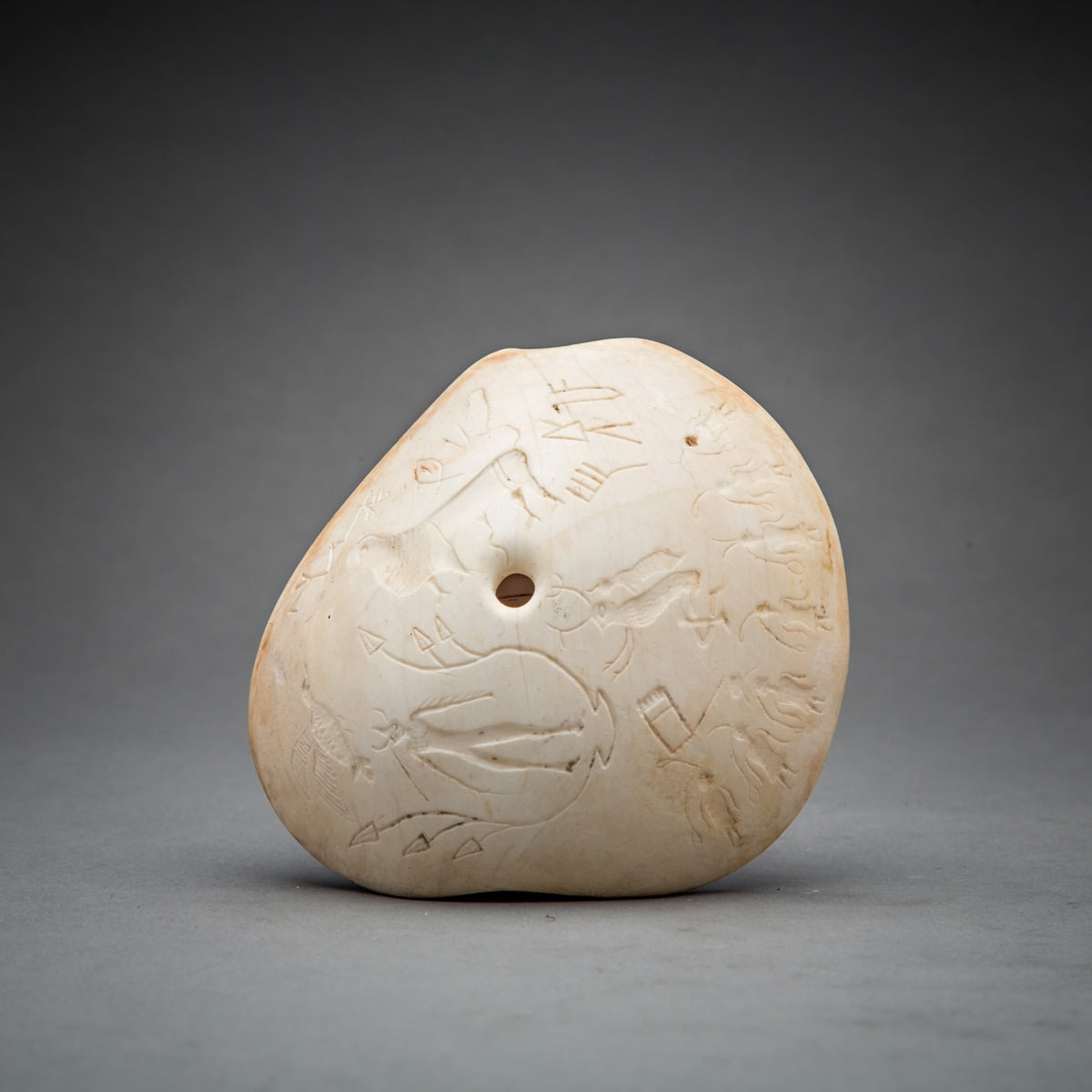Incised Indus Valley Shell, 3000 BCE - 2000 BCE
Shell
10.2 x 10.2 cm
4 x 4 in
4 x 4 in
AM.0362
The Indus Valley civilisation was re-discovered in the 1920s when excavations in Pakistan and northwestern India revealed the existence of sophisticated urban settlements which flourished c. 2600- 1900 B.C. These...
The Indus Valley civilisation was re-discovered in the 1920s when excavations in Pakistan and northwestern India revealed the existence of sophisticated urban settlements which flourished c. 2600- 1900 B.C. These developed in the same period as city-states in Egypt and Mesopotamia but along very different lines. Whereas the former were dominated by royal and religious leaders, the Indus Valley cities seem to have been run by a wealthy mercantile elite. Society was organised according to the demands of trade with regular town planning, a standardised system of weights and measures and a developed division of labour. Burial practices also differed markedly from other ancient civilisations. The deceased were interred in wood coffins with pottery vessels and simple ornaments but valuable objects of gold, silver or precious stones were bequeathed to living relatives and therefore kept in circulation.
Long-distance trade was important to the economy and exotic goods were transported by pack animals, riverboats and bullock carts. Indus Valley seals have been found across the Near East and surviving artefacts, such as this incised shell, testify to the movement of goods over a wide area. There were three main sources for marine shell: the Gulf of Kutch and Saurashtra to the east, the coast west of Karachi and the Omani coast. Complete shells as well as partly processed shell ornaments were traded to the large cities where they were finished according to local specifications by highly skilled artisans. The most common objects manufactured from shell were bangles, ritual ladles and inlays for wooden furniture or stone sculpture. This piece is slightly unusual in that it has a carefully worked hole in the centre. It may have been worn and suspended from a string or attached to a larger structure. Shell containers were also used for cosmetic pigments. As these functions imply, this material was confined to high status items intended to display the wealth and taste of their owners.
The subject matter of the incised design is religious. As no temple-like structures have been excavated it seems likely that communal worship took place in the open air or beneath the trees that were held to be sacred. To the left of the shell a horned deity stands in a pipal tree with triangular shaped leaves. Below this, to the right, kneel two worshippers with avian faces and horned headdresses. Along the bottom edge is a procession of seven standing figures with plumed headdresses and tunic-like apparel. They may represent priests or worshippers. To the right of the pipal tree is a curious animal with the head of a bird but the body of a bull or ram. A more naturalistic bird is depicted in flight above the pipal tree. Several script signs also appear, for example below the base of the tree. Their meaning is unclear as the Indus Valley script is yet to be deciphered.
The detail of the carving is astounding, as is the complexity of the design. This is a unique object that gives a fascinating insight into one of the earliest urban cultures in the ancient world. (AM)
Long-distance trade was important to the economy and exotic goods were transported by pack animals, riverboats and bullock carts. Indus Valley seals have been found across the Near East and surviving artefacts, such as this incised shell, testify to the movement of goods over a wide area. There were three main sources for marine shell: the Gulf of Kutch and Saurashtra to the east, the coast west of Karachi and the Omani coast. Complete shells as well as partly processed shell ornaments were traded to the large cities where they were finished according to local specifications by highly skilled artisans. The most common objects manufactured from shell were bangles, ritual ladles and inlays for wooden furniture or stone sculpture. This piece is slightly unusual in that it has a carefully worked hole in the centre. It may have been worn and suspended from a string or attached to a larger structure. Shell containers were also used for cosmetic pigments. As these functions imply, this material was confined to high status items intended to display the wealth and taste of their owners.
The subject matter of the incised design is religious. As no temple-like structures have been excavated it seems likely that communal worship took place in the open air or beneath the trees that were held to be sacred. To the left of the shell a horned deity stands in a pipal tree with triangular shaped leaves. Below this, to the right, kneel two worshippers with avian faces and horned headdresses. Along the bottom edge is a procession of seven standing figures with plumed headdresses and tunic-like apparel. They may represent priests or worshippers. To the right of the pipal tree is a curious animal with the head of a bird but the body of a bull or ram. A more naturalistic bird is depicted in flight above the pipal tree. Several script signs also appear, for example below the base of the tree. Their meaning is unclear as the Indus Valley script is yet to be deciphered.
The detail of the carving is astounding, as is the complexity of the design. This is a unique object that gives a fascinating insight into one of the earliest urban cultures in the ancient world. (AM)



